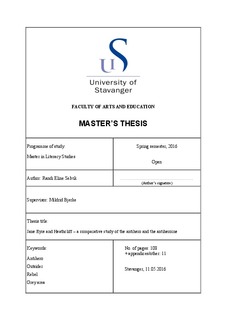| dc.description.abstract | This thesis has two major purposes: to examine the concept antihero and to discuss if the literary figures of Charlotte Brontë’s Jane in Jane Eyre (1847) and Emily Brontë’s Heathcliff in Wuthering Heights (1847), conform to the accepted conventions of the antihero. It studies the wide and complex concept, and tries to make it more understandable by confining it into ‘a grey area’. Further, it compares and contrasts Jane and Heathcliff, and uses the concept of the antihero to gain a better understanding of these characters. Finally, it looks at the relationship between female antiheroines and male antiheroes, to see if there are notable differences between these two types of antiheroes.
The literature review offers a theoretical background for this thesis, as it presents earlier research on the concept itself, as well as research on Jane and Heathcliff in relation to the concept. The primary critics that will be discussed in this chapter with connection to Jane is Helen Moglen, who states that Jane was the first antiheroine, and Carol Pearson and Katherine Pope, who disagrees and states that she is a heroine. The primary critics that will be discussed in this chapter with connection to Heathcliff, is Peter L. Thorslev, who argues that Heathcliff is an antiheroic Byronic hero, and Walter Reed, who claims that Heathcliff is a Romantic hero. Moreover, it discusses Bernard Paris’s statement where he asserts that Heathcliff escapes the villain label because his evil actions derive from the mistreatment he has been a victim of. The literature review is followed by an in-depth discussion about the concept antihero, where its meaning, origin and purpose are in focus. The aim with this chapter is to set the base for the two following chapters, which are the analyses of Jane and Heathcliff as antiheroes.
This study shows that Jane and Heathcliff can be perceived as antiheroes, because their primary aim with their rebellious behaviour is justice. However, it has also shown that whether Jane is called an antiheroine or a heroine seems to be two sides of the same coin, because for the same reasons some interprets her as an antiheroine, she is perceived as a heroine by others. The perceptions of Heathcliff depend on whether or not the readers are able to sympathise with him, and thus excuse his malevolent actions, or if they are only able to view him as a villainous character. The different interpretations of these two characters indicate that the concept, the grey area they operate within, always is in flux. As society and its principles change, and the tolerance and acceptance increase, the confinements of the concept adjusts with it. | nb_NO |

